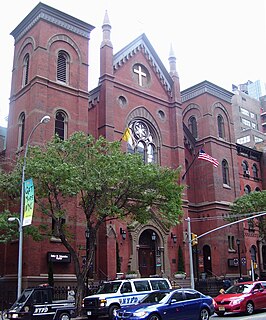
Lincoln Cathedral, Lincoln Minster, or the Cathedral Church of the Blessed Virgin Mary of Lincoln and sometimes St Mary's Cathedral, in Lincoln, England, is the seat of the Anglican Bishop of Lincoln. Construction commenced in 1072 and continued in several phases throughout the medieval period. Like many of the medieval cathedrals of England it was built in the Gothic style.

Bath Abbey is an Anglican parish church and former Benedictine monastery in Bath, Somerset, England. Founded in the 7th century, it was reorganised in the 10th century and rebuilt in the 12th and 16th centuries; major restoration work was carried out by Sir George Gilbert Scott in the 1860s. It is one of the largest examples of Perpendicular Gothic architecture in the West Country. The cathedral was consolidated to Wells Cathedral in 1539 after the abbey was dissolved in the Dissolution of the Monasteries, but the name of the diocese has remained unchanged.

St Botolph's Church is a parish church in the Church of England in Boston, Lincolnshire. It is notable for its extraordinarily tall tower, 266 feet 9 inches (81.31 m) tall, informally known as the "Boston Stump" since its construction. It was long used as a landmark for sailors, and on a clear day can be seen from Norfolk.

Beverley Minster in Beverley, East Riding of Yorkshire, is a parish church in the Church of England. It is one of the largest parish churches in the UK, larger than one-third of all English cathedrals and regarded as a gothic masterpiece by many.

Gloucester Cathedral, formally the Cathedral Church of St Peter and the Holy and Indivisible Trinity, in Gloucester, England, stands in the north of the city near the River Severn. It originated in 678 or 679 with the foundation of an abbey dedicated to Saint Peter.

Carlisle Cathedral is the seat of the Anglican Bishop of Carlisle in Carlisle, Cumbria, England. It was founded as an Augustinian priory and became a cathedral in 1133.

Ohrdruf is a small town in the district of Gotha in the German state of Thuringia. It lies some 30 km southwest of Erfurt at the foot of the northern slope of the Thuringian Forest. The former municipalities Crawinkel, Gräfenhain and Wölfis were merged into Ohrdruf in January 2019.

The Holy Name of Jesus Roman Catholic Church is a parish church of the Roman Catholic Archdiocese of New York located at 207 West 96th Street at the corner of Amsterdam Avenue in the Morningside Heights neighborhood of Manhattan, New York City. It was built in 1900 and was designed by Thomas H. Poole in the Gothic Revival style.

The Sophienkirche was a church in Dresden.

Holy Cross Church is a Roman Catholic church located at 329 West 42nd Street between Eighth and Ninth Avenues in the Hell's Kitchen neighborhood of Manhattan, New York City, near Times Square and across the street from the Port Authority Bus Terminal.

The Beethoven House in Bonn, Germany, is a memorial site, museum and cultural institution serving various purposes. Founded in 1889 by the Beethoven-Haus association, it studies the life and work of composer Ludwig van Beethoven.

St. James’s Church is one of two Roman Catholic churches in the parish of Heiligenstadt in the 19th district of Vienna, Döbling. It stands at the Pfarrplatz and is dedicated to James, son of Zebedee.

St. Bonifatius in Wiesbaden, Germany, is the central Catholic parish and church in the capital of Hesse. The present building was designed by architect Philipp Hoffmann in Gothic Revival style and built from 1844 to 1849. Its twin steeples of 68 m dominate the Luisenplatz. The parish is part of the Diocese of Limburg.
The Church of St. John the Baptist is a Roman Catholic parish church in the Roman Catholic Archdiocese of New York, located at 211 West 30th Street between Seventh and Eighth Avenues in the Fur District of the Chelsea neighborhood of Manhattan, New York City. To the church's rear is the Capuchin Monastery of St. John the Baptist, located at 210 West 31st Street across from Pennsylvania Station and Madison Square Garden.

St. Peter is a Romanesque church in Syburg, now a suburb of Dortmund, Germany. It is the active Protestant parish church of Syburg, officially named "Ev. Kirche St. Peter zu Dortmund-Syburg". It serves as a concert venue for the bimonthly Syburger Sonntagsmusiken.

Ludwig van Beethoven the Elder, also Ludovicus van Beethoven, born Lodewijk van Beethoven was a professional singer and music director, best known as the grandfather of the composer Ludwig van Beethoven.

St. Michaelis is one of the main churches in Lüneburg, Lower Saxony, Germany. It was first an abbey church of the former monastery of Benedictines, built from 1376 in brick Gothic style. It became Lutheran during the Reformation. Johann Sebastian Bach was for two years a pupil at the school of St. Michaelis.

The Franciscan Monastery is located near the Main Square in Plzeň, Czech Republic. Originally Minorites, later Franciscan monastery was founded in the end of 13th century. Church of Assumpton of Virgin Mary, Chapterhouse and Chapel of St. Barbara also belong to the monastery complex.



























